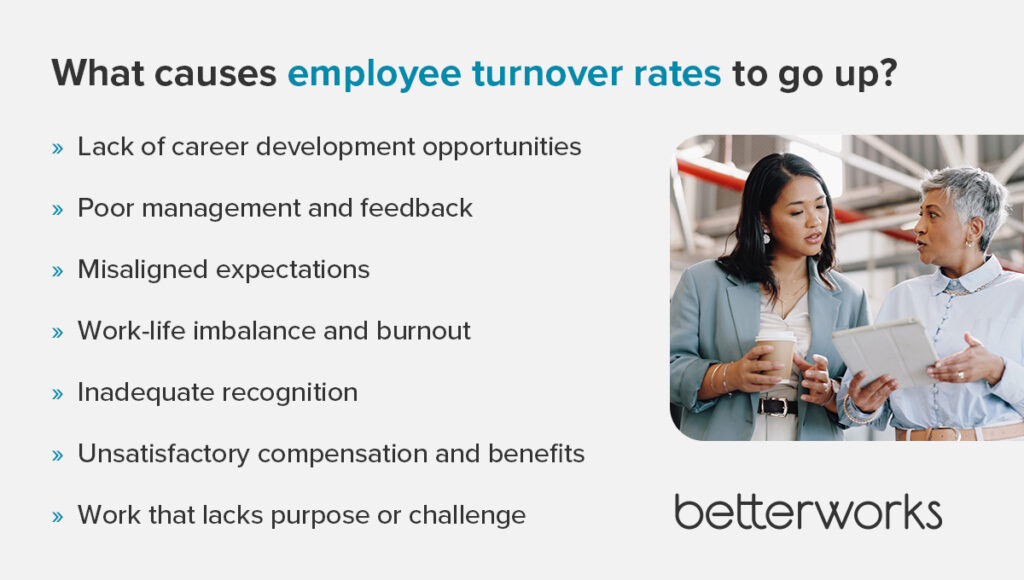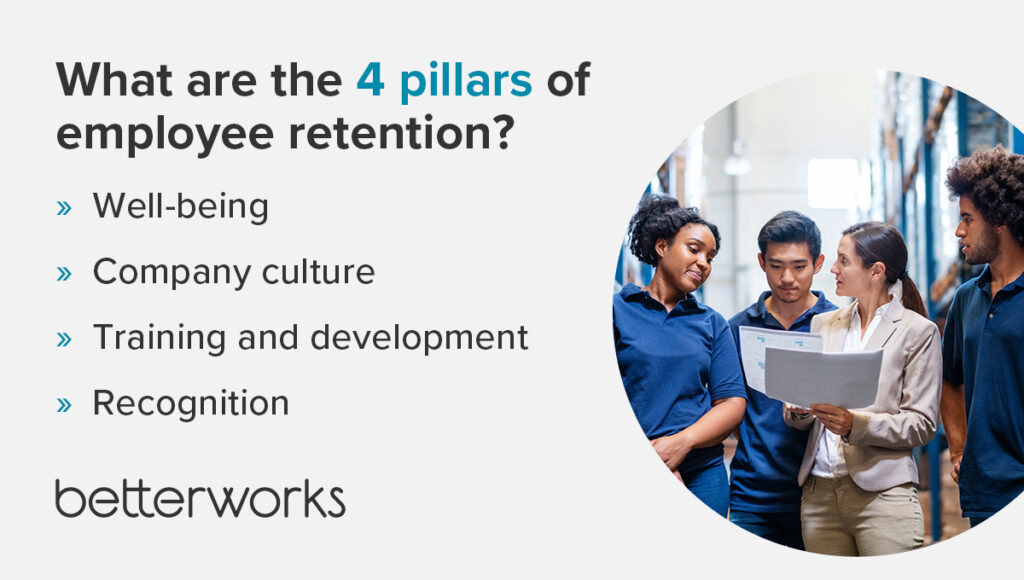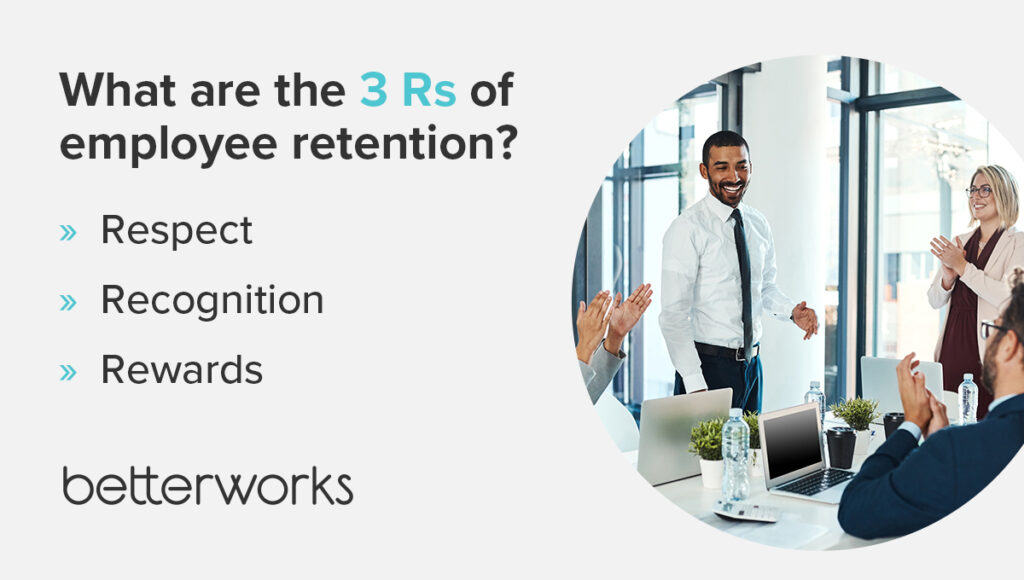- What is employee turnover?
- 20 ways to reduce staff turnover
- Clarify career paths
- Offer flexible scheduling
- Provide clear performance goals
- Build a culture of continuous feedback
- Reward and recognize employees
- Support strong manager-employee relationships
- Promote internal mobility
- Invest in employee development
- Conduct regular performance assessments
- Enable peer-to-peer recognition
- Create a feedback-forward culture
- Offer competitive compensation
- Make culture visible and lived
- Measure employee engagement
- Link work to purpose
- Improve the onboarding experience
- Hold managers accountable for retention
- Prevent burnout before it happens
- Celebrate steady progress, not just big wins
- Ask employees what they need—and follow through
- Frequently asked questions: Retention frameworks
- Your people are your competitive edge
For HR leaders, reducing turnover isn’t about isolated team issues. It’s about protecting business continuity, preserving institutional knowledge, and maintaining the capacity to grow. If you’re looking at how to reduce turnover, the real questions are where it’s hurting performance, how much it’s costing you, and what action will make a difference.
Replacing a single employee can cost 50% to 200% of their salary, but the bigger loss comes when long-tenured talent walks out the door, taking relationships, expertise, and momentum with them.
The path to reducing staff turnover starts with clarity: understanding what’s driving people away, and what it takes to keep your best people engaged and invested.
What is employee turnover?
Employee turnover refers to the rate at which employees leave your organization (voluntarily or involuntarily) over a given time period.
To calculate your employee turnover rate, divide the number of employees who leave during a specific time frame by the number of employees working during that time frame. Multiply by 100 to get your employee turnover rate.
Some industries, such as food services, and hospitality, experience higher employee turnover rates. Public agencies, finance and insurance, and wholesale trade industries tend to see the lowest employee turnover rates.
There’s no universal “right” number. But when turnover starts trending higher, it can be a warning sign of coming troubles.
What causes employee turnover rates to go up?
Before you can reduce employee turnover, you need to understand what’s driving it. Learn some of the most common factors behind rising attrition, particularly among top performers. Spot these early, and you have a chance to shift the trajectory. Miss them, and you risk losing the very people you can least afford to lose.
- Lack of career development opportunities: When employees can’t see what’s next, they start looking elsewhere. High performers, in particular, won’t stick around if they feel stuck. They crave growth, and if they can’t find it inside your organization, they’ll find it outside.
- Poor management and feedback: Consistent, constructive dialogue between employees and managers isn’t just nice to have—it’s essential. When feedback is sporadic, vague, or nonexistent, trust breaks down. Weak performance management systems can leave employees feeling invisible, undervalued, or directionless.
- Misaligned expectations: Clarity matters from day one. If expectations are murky or change without warning, employees are more likely to disengage. High performers want to know what success looks like, and they need consistency to deliver it.
- Work-life imbalance and burnout: When people are stretched too thin for too long, they break. Lack of flexibility, unmanageable workloads, and always-on cultures lead directly to burnout.
- Inadequate recognition: Recognition doesn’t need to be flashy, but it does need to be meaningful. When employees—especially top contributors—feel like their efforts go unnoticed or unrewarded, motivation takes a hit. Over time, so does retention.
- Unsatisfactory compensation and benefits: If your pay and perks aren’t competitive or clearly tied to performance, your top talent will take the hint. A strong compensation strategy signals your values.
- Work that lacks purpose or challenge: Employees want to make an impact. When their work feels monotonous, disconnected from the bigger picture, or devoid of meaning, they check out—sometimes for good.
Each of these factors is not just a data point. It’s an opportunity. When you listen to what your employees are experiencing and respond with intention, you’re not just reducing turnover. You’re building a workplace where your best people want to stay, grow, and thrive.

20 ways to reduce staff turnover
Reducing turnover doesn’t happen by accident. It takes intentional strategy, the right tools, and leadership commitment. These 20 ideas will help you reduce employee turnover and improve your organization’s talent retention strategy.
Clarify career paths
When employees can see a future at your organization, they’re more likely to stay. Career paths help people visualize how they can grow within the company rather than seeking new opportunities elsewhere. Use Betterworks to map development plans and track progress against long-term goals, so employees feel like they’re working toward something meaningful.
Offer flexible scheduling
Flexible work options—whether those are hybrid, remote, or adjusted hours—help people manage personal responsibilities without sacrificing their careers. This flexibility reduces stress, boosts job satisfaction, and keeps turnover low, especially for working parents or caregivers who might otherwise feel forced to leave.
Provide clear performance goals
When expectations are murky, frustration sets in. Clear, measurable goals give employees direction and purpose, helping them stay focused and motivated. Betterworks makes it easy for managers and employees to set aligned goals and track them consistently, reducing uncertainty and disengagement that often lead to turnover.
Build a culture of continuous feedback
Employees want to know how they’re doing more than once or twice a year. Regular feedback and coaching build trust, drive performance, and prevent issues from festering, improving the overall employee experience and reducing attrition. With Betterworks, you can embed structured check-ins into the flow of work, making feedback a habit instead of an afterthought.
Reward and recognize employees
Appreciation goes a long way. When people feel seen for their efforts, they’re more likely to stay loyal. Manager-led recognition programs boost employee morale and reinforce positive behaviors. Make it a regular practice tied to goals, values, and outcomes.
Support strong manager-employee relationships
Employees don’t quit companies; they quit managers. Great managers coach, listen, and advocate for their people. When you enable managers to lead more effectively, you strengthen the foundation of every team. Betterworks equips managers with prompts, templates, and insights for better one-on-one conversations, demonstrating the impact of performance enablement on building stronger, more connected relationships between managers and employees.
Promote internal mobility
Lack of career growth is a top reason people leave. Help employees see what’s possible beyond their current roles. Track skills, identify internal candidates, and use performance data to connect high-performers to new challenges. This boosts retention by rewarding ambition and initiative.
Invest in employee development
Development isn’t just a perk: it’s a retention strategy. Offer training programs, stretch assignments, or mentorship that help people grow. With Betterworks, you can align development plans with performance goals, ensuring continuous and personalized growth.
Conduct regular performance assessments
A strong performance management assessment helps employees understand where they stand and how they can improve. Regular evaluations keep performance conversations on track and highlight top talent. With Betterworks, you can streamline assessments to focus on growth, not bureaucracy.
Enable peer-to-peer recognition
Hearing “great job” from a manager is great, but hearing it from a peer can be even more meaningful. Peer recognition builds community, boosts morale, and reinforces a culture of appreciation. That sense of belonging reduces the risk of disengagement and exit.
Create a feedback-forward culture
Feedback shouldn’t feel risky or uncomfortable. When your culture encourages honest, respectful feedback at every level, employees grow faster and feel safer. That psychological safety supports retention by giving people the tools to work through problems rather than walk away.
Offer competitive compensation
Annual salary matters, especially in a competitive talent market. While pay alone won’t retain top performers, it needs to be fair and competitive. Regularly review your compensation strategy to help ensure your high performers feel valued and stay invested in their roles.
Make culture visible and lived
Creating a positive culture doesn’t mean having snacks in the breakroom. It means aligning your values with daily actions, rewards, and expectations. Tools like Betterworks help you connect culture to performance, reinforcing values through feedback, goal-setting, and recognition.
Measure employee engagement
You can’t reduce turnover if you don’t know who’s disengaging. Use surveys and sentiment analysis to track how employees feel. Betterworks helps you gather real-time insights and take action before someone updates their résumé.
Link work to purpose
Employees want more than a paycheck; they want to know their work matters. Connect individual goals to broader business outcomes to create a sense of purpose. Betterworks makes this easy by aligning goals across teams and surfacing impact across the organization.
Improve the onboarding experience
First impressions stick. A chaotic or impersonal onboarding process can lead to early exits. Help new hires feel welcomed, informed, and connected from day one. Set early goals, provide mentors, and schedule regular check-ins to build commitment.
Hold managers accountable for retention
Retention isn’t just an HR metric; it’s a leadership responsibility. Give managers visibility into engagement, performance, and turnover patterns so they can act early. With Betterworks, you can equip managers with real-time insights to spot and address risk.
Prevent burnout before it happens
Burnout is one of the most preventable causes of turnover. Look for early warning signs like missed deadlines, quiet meetings, or dips in performance. Use one-on-ones to check in on well-being and workloads, and adjust goals as needed to protect long-term performance and healthy work-life balance.
Celebrate steady progress, not just big wins
Employee recognition doesn’t have to be flashy. Acknowledging someone for a milestone, an idea, or steady progress can go a long way. Celebrating small wins reinforces high-performing habits and makes employees feel like their contributions matter.
Ask employees what they need—and follow through
Want to know how to reduce turnover? Ask your employees. Surveys, open conversations, and listening sessions help surface what’s working and what’s not. Betterworks allows you to capture that input, turn it into action, and track progress transparently.
Frequently asked questions: Retention frameworks
There’s no one-size-fits-all solution to employee churn, but there are proven frameworks that help explain what makes employees stay. Each model below offers a different lens for understanding how to reduce turnover in the workplace, from career development and company culture to recognition and rewards.
What are the 5 Cs of retention?
The 5 Cs—career, community, clarity, communication, and connection—are foundational to keeping employees engaged and committed for the long term.
- Career: Employees want to grow. Offer clear career paths and development opportunities to help them see a future at your company.
- Community: A strong sense of belonging drives retention. Foster inclusive teams and a culture where employees feel seen and supported.
- Clarity: Employees are more likely to stay when they know what’s expected. Set clear goals, define success, and keep communication transparent.
- Communication: Convey company values and decisions openly. Employees who understand the “why” behind business moves are more likely to stay invested.
- Connection: Strong relationships—especially with managers—are a key predictor of retention. Prioritize meaningful conversations and feedback.

What are the 4 pillars of employee retention?
These four pillars represent the key areas where HR leaders can influence the employee experience.
- Well-being: Support physical, emotional, and mental health through flexible scheduling, workload balance, and access to benefits.
- Company culture: Culture shapes how people feel about work. Align your performance management practices with your values to reinforce a culture of trust and growth.
- Training and development: People stay when they’re learning. Offer stretch assignments, coaching, and skill-building tools to keep employees engaged.
- Recognition: Don’t wait for anniversaries to celebrate impact. Regular, personalized recognition helps employees feel valued and motivated to stay.

What are the 3 Rs of employee retention?
The 3 Rs—respect, recognition, and rewards—focus on how you treat employees day to day.
- Respect: Employees want to be trusted, listened to, and treated fairly. Respect is the baseline for retention.
- Recognition: Appreciation should be timely, specific, and frequent. A culture of recognition helps employees stay engaged and connected.
- Rewards: Compensation still matters. Competitive pay, bonuses, and meaningful perks help you retain top performers in a competitive talent market.

Your people are your competitive edge
To build a thriving organization, you need to know how to reduce turnover and keep your best people growing. By investing in career development, enabling great management, and recognizing employees meaningfully, you create an environment where top talent wants to stay.
With Betterworks, you can embed performance enablement practices, such as goal setting, regular feedback, and one-on-one conversations, into your daily operations, reinforcing long-term engagement. The result? A culture where people thrive and your business grows stronger with every employee who chooses to stay.
Build a culture of engagement, growth, and continuous feedback with Betterworks


